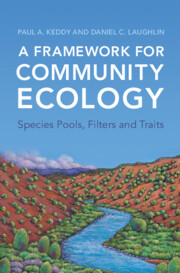Book contents
- A Framework for Community Ecology
- A Framework for Community Ecology
- Copyright page
- Contents
- Preface
- 1 A General Framework for Community Ecology
- 2 Filters
- 3 Species Pools
- 4 Traits
- 5 Trait–Environment Interactions
- 6 Functional Groups
- 7 Predictive Models of Community Assembly
- 8 Prospects and Possibilities
- References
- Index
8 - Prospects and Possibilities
Published online by Cambridge University Press: 18 November 2021
- A Framework for Community Ecology
- A Framework for Community Ecology
- Copyright page
- Contents
- Preface
- 1 A General Framework for Community Ecology
- 2 Filters
- 3 Species Pools
- 4 Traits
- 5 Trait–Environment Interactions
- 6 Functional Groups
- 7 Predictive Models of Community Assembly
- 8 Prospects and Possibilities
- References
- Index
Summary
We suggest (Proposition 5) that a community is functionally assembled when there is at least one species representing each functional type that is adapted to the habitat. We suggest (Proposition 6) that a community is fully assembled when each functional type has the maximum number of species that can coexist. Much biological diversity lies in the lower tail of the log-normal distribution, yet ecologists frequently trim this tail of rare species to construct models. The rising tide of species extinctions requires us to revisit this procedure, and to consider how to include conservation of rare species in models for community assembly. This requires us to recognize that there are two types of “rare” species in ecological data sets: those that are merely rare in samples and those that are designated as globally rare and at risk of extinction. Most communities arise from pre-existing communities, so when filters change there is often inertia in community response, and this inertia is related to traits. The principles laid out in this book provide a guide not only to theoretical understanding but for the challenges of ecological restoration.
Keywords
- Type
- Chapter
- Information
- A Framework for Community EcologySpecies Pools, Filters and Traits, pp. 265 - 319Publisher: Cambridge University PressPrint publication year: 2021

